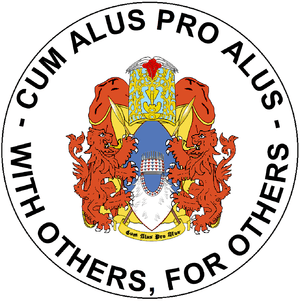Royal Order of the Engabu
| Royal Order of the Engabu | |
|---|---|
|
Shield of the Order | |
| Awarded by Omukama of Bunyoro | |
| Type | Single-grade royal order |
| Eligibility | Any individual, above the age of 25 |
| Awarded for | All that makes for the spiritual and moral strengthening of mankind and Bunyoro-Kitara Kingdom in particular, and those who promote work for humanity and charity, for the relief of persons in sickness, distress, suffering or danger |
| Motto | “Cum Alus Pro Alus” |
| Post-nominals | OEBKK |
| Statistics | |
| Established | June 18th 2010 |
| Precedence | |
| Next (higher) | Royal Order of the Omujwaara Kondo |
| Next (lower) | Most Honorable Order of Omukama Chwa II Kabalega |
The Order of the Engabu (English: Order of the Shield) is a single-grade royal order, within the Kingdom of Bunyoro in Uganda and is awarded solely by the Omukama of Bunyoro. The order was established in 2010, replacing the old Royal Order of the Crown. The name change was done to make sure that the Order of the Crown and the Order of the Coronet Wearer were not confused. The honor is junior to the ancient Royal Order of the Omujwaara Kondo. It is normally granted twice a year, once during the Empango ceremony (which most often is on June 11 each year) and the other on the birthday of the Omukama (H.M. Solomon Iguru I's birthday is June 18)
Originally the recipients of The Order of the Engabu received a breast star that is 90 millimeters in diameter. This star is worn at Empango ceremonies or other appropriate formal occasions, and members of the order sit in a special place of honor during the Empango events. Originally recipients of the Order of the Engabu were required to attend the Empango ceremony within a few years of receiving the order, but as of May 7, 2014 this practice has been waived.[1]
The Order have been researched and recognized by the Augustan Society.[2]
Intergenerational transfer rules
Similarly to the Order of the Omujwaara Kondo, the honor is inherited by the original grantee's eldest child of the same sex at the moment of the original grantee's death or renunciation of the honor. Intergenerational transfer rules for the honor are described in Statute 8. For male grantees, the honor passes by patrilineal primogeniture. For female grantees, the honor passes by matrilineal primogeniture
Titles
There are several aspects of the award that recipients of the Order receive, and these are akin to Order of the Omujwaara Kondo and are mentioned in Section 5(b) of the Order's statutes.[3]
- First, all recipients are entitled to the style "The Most Honourable". However, persons entitled to an existing style that supersedes "The Most Hon." will retain it within the Order's records.
- Second a recipient is entitled to use the title of Omukungu (which is a less prestigious title than Omujwaara Kondo). Official authorization is granted for a male recipient to translate Omujwaara Kondo into "Knight" in English and a female recipient may translate this into "Dame".
- Third, the post-nominal of "OEBKK" may be used after an honoree's name, which stands for (O)rder of the (E)ngabu of (B) unyoro-(K)itara (K)ingdom.
- The original recipient of the Order may use "1st" before the post-nominals (OEBKK) in order to show he is the first to receive the Order, his son who inherits the order may then use "2nd OEBKK", his son may use "3rd OEBKK" and so on.
Thus, a typical modern recipient of the Order would be styled The Most Hon. Omukungu First Name Surname, 1st OEBKK.
Heraldic privileges
Additionally, per Section 20 of the Order's statutes, persons who receive the honor are also entitled to the right to display certain heraldic privileges. This section reads: 20. Heraldry of Members Heraldry has historically been limited in Bunyoro-Kitara Kingdom, with the exception of the Kingdom having an armorial achievement in the ensign of its historical flag and His Majesty the Omukama having similar heraldry. However, to honor some Members whose ancestors maintained heraldic customs, by authorization of His Majesty the Omukama, all Members of the Order who desire to have heraldry are entitled to display supporters and top their helm with a basic coronet if they desire to signify their status as Members.
Images of the order
 Sash and Breast Star of the Order |
 Collar of the Order of the Engabu |
 Picture of the Breast Star of the Order |
